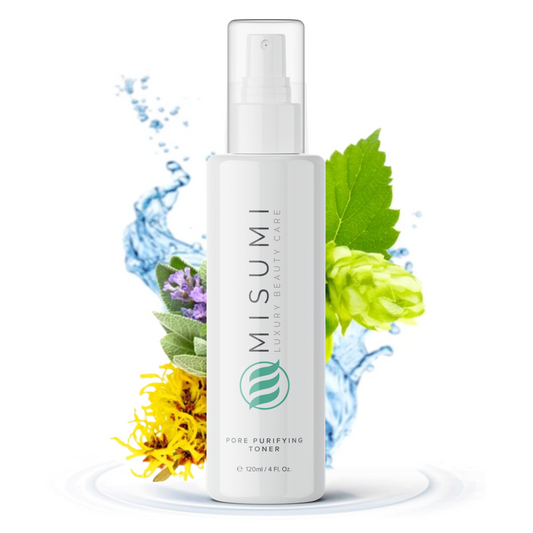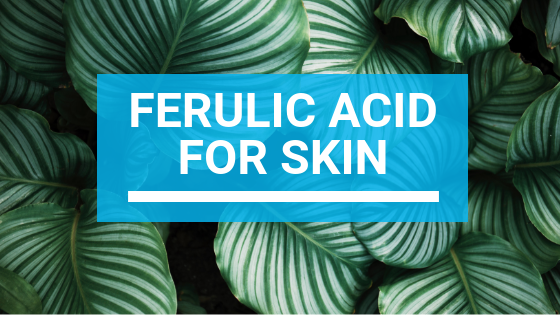Taking good care of your skin in this day and age isn't easy. The number of skincare ingredients and substances keeps expanding, and all the different acronyms are beginning to feel endless.
By now, you have undoubtedly heard of salicylic acid, lactic acid, hyaluronic acid, AHAs and BHAs, and so on. But have you heard about ferulic acid? Here's all you need to know about this substance for the skin.
What is Ferulic Acid?
Ferulic acid is a powerful antioxidant primarily used in anti-aging skincare products. Ferulic acid, derived from plants, is found in foods such as oats, bran, rice, citrus fruits, eggplants, apple seeds, etc. But why is it so highly sought after?

As far as antioxidants go, ferulic acid protects the body from damage. That's right - it's capable of hunting down free radicals in the body and getting rid of them. Free radicals are a class of substances that cause damage to the DNA of our body cells and skin cells, mainly by inducing oxidative stress within them.
But incorporating ferulic acid into your diet and skincare routine won't just neutralize free radicals. Its specific benefits lie in its ability to bolster the effectiveness of other antioxidants. Mainly, ferulic acid boosts the restorative properties of vitamin C, vitamin A, and vitamin E. This makes ferulic acid a very popular substance in the skincare industry, mostly marketed as "ferulic acid serums." It can also be found in several anti-aging products.
What is Ferulic Acid Used For, and How?
Apart from being a common ingredient in a wide array of anti-aging creams, serums, gels, and more, ferulic acid can also be found as a supplement.
Since its main function is ridding the body (and the skin) of harmful free radicals, ferulic acid is predominantly used for combating signs of aging. Typically, these include the removal of persistent sunspots, the reduction of wrinkles, and the treatment of skin discoloration. Ferulic acid serum is often promoted as a skin-lightening agent, a job it does pretty well.

As we pointed out above, ferulic acid can also be taken as an oral supplement. Generally, ferulic acid supplements can be taken daily with no side effects. Besides helping the body rejuvenate itself (all thanks to its antioxidant properties), taking ferulic acid as a supplement can even alleviate the symptoms of people with pulmonary hypertension and diabetes.
However, if your main goal is maintaining healthy skin, taking ferulic acid as a supplement won't help. This acid is by far the most effective when used topically as part of the many ferulic acid skincare products available today. Why, you might ask? Let's see what the benefits of ferulic acid for the skin are.
Ferulic Acid For Skin
When used in skin creams or serums, ferulic acid acts as a booster for other antioxidant substances, particularly vitamin C. Its effectiveness increases when combined with other antioxidants.
You might have noticed that vitamin C is another common ingredient in tons of anti-aging skincare products. However, it's rarely used on its own. This is because the molecular structure of vitamin C prevents it from attaining a stable shelf-life. For example, vitamin C is vulnerable to sunlight, which breaks it down after short exposure. This is why skincare products containing vitamin C, such as creams, gels, or serums, come packaged in opaque, dark, and often amber-hued bottles. The packaging acts as a protective filter that prolongs the shelf-life of the vitamin.
But this is where ferulic acid comes into play. By adding it to products that contain vitamin C, ferulic acid makes the vitamin more resistant. The molecular structure of ferulic acid provides what scientists call "photoprotection," - meaning that it can minimize damage from exposure to sunlight. This is why ferulic acid is prized so much and why you can increasingly find it featured in products lining the shelves of cosmetic stores.

But the photoprotective properties of ferulic acid don't end with vitamin C. This protective ability of this acid becomes even stronger the more vitamins you throw at it. For example, a research study in 2005 found that ferulic acid doubled its photoprotective efficiency when combined with both vitamins E and C. This didn't only prolong the shelf-life of the vitamins involved. The researchers remarked that combining vitamins C and E with ferulic acid could prolong people's lives, combat aging, and possibly even prevent skin cancer.
More research is needed, but what we know so far tells us that ferulic acid is not just a potent antioxidant but that it's also very efficient in protecting our bodies from excessive exposure to the sun. Additionally, it has a powerful strengthening effect on other strong antioxidants like vitamins C and E, prolonging their shelf-life and boosting their healthy properties. But that's not all that ferulic acid can do.
Ferulic Acid For Skin Lightening
That's right; this amazing natural substance has another trick up its sleeve. Ferulic acid is increasingly used in skin care products to produce skin-lightening effects and even skin tone.
In 1999, scientists discovered that ferulic acid combined with vitamin E could prevent and even revert hyperpigmentation, or the darkening of the skin. When used in tandem, the researchers found vitamin E and ferulic acid can indirectly inhibit melanin production by stopping the production of tyrosine hydroxylase, a rate-limiting enzyme.

With the inhibition of the production of melanin pigment in the body (called melanogenesis), ferulic acid and vitamin E can prevent hyperpigmentation and other types of skin discoloration. So if you're suffering from dull skin or an uneven skin tone, get yourself a ferulic acid product.
Ferulic Acid Side Effects
So far, the overwhelming consensus seems to be that ferulic acid is safe for most people. That goes for most skin types, with the possible exception of people with sensitive skin.
While you probably already have ferulic acid floating about your body, the topical application of the substance on the skin's surface might produce unpleasant reactions. People with sensitive skin might experience various side effects when using a product containing ferulic acid. Reactions typically include itching, redness, or flaking. In rare cases, you might even get a rash or an outbreak of hives.
To avoid side effects when using ferulic acid topically, it's always wise to perform a patch test. A patch test will help you determine how your skin will react when it comes into contact with a substance or a product. For example, lemon juice can often cause irritation in some people due to its high level of acidity.

So far, the overwhelming consensus seems to be that ferulic acid is safe for most people. That goes for most skin types, with the possible exception of people with sensitive skin.
While you probably already have ferulic acid floating about your body, the topical application of the substance on the skin's surface might produce unpleasant reactions. People with sensitive skin might experience various side effects when using a product containing ferulic acid. Reactions typically include itching, redness, or flaking. In rare cases, you might even get a rash or an outbreak of hives.
To avoid side effects when using ferulic acid topically, it's always wise to perform a patch test. A patch test will help you determine how your skin will react when it comes into contact with a substance or a product. For example, lemon juice can often cause irritation in some people due to its high level of acidity.

A patch test is very simple and easy to perform. First, choose a small area of your skin where you want to test the substance, product, or ingredient. Then, apply a small amount of the substance you're testing. Wrap the area with a bandage and wait between 24 to 48 hours to give the skin time to react to the substance.
Of course, if you start to feel any unpleasant sensations (such as burning or intense itching), remove the bandage and wash the area with soap and water.
If you don't experience any redness, flaking, itching, soreness, pain, or tingling, then ferulic acid is safe for you to use. However, if you experience unpleasant and persistent side effects, forget about using that product. It won't hurt to schedule an appointment with your doctor or dermatologist for additional advice.

Frequently Asked Questions: Ferulic Acid For Skin - The Ultimate Guide
Which is better, hyaluronic acid or ferulic acid?
Both hyaluronic acid and ferulic acid offer unique benefits, making them essential components of a well-rounded skincare routine. Hyaluronic acid is known for its incredible moisture-retaining abilities, making it an excellent ingredient for hydrating the skin.
Ferulic acid, on the other hand, is celebrated for its antioxidant properties, which help protect the skin from environmental stressors and free radical damage. Depending on your skin type and concerns, you may find one more effective for your needs. However, both ingredients can work together in your skincare routine for optimal results.
Can I use ferulic acid every day?
Yes, you can use ferulic acid daily as part of your skincare routine. Its antioxidant properties make it an excellent daily defense against environmental stressors and oxidative damage. When used consistently, ferulic acid can help improve the overall appearance and health of your skin. However, always follow the manufacturer's recommendations and patch test any new skin care products to ensure compatibility with your skin type before adding ferulic acid to your routine.
Is ferulic acid suitable for oily skin?
Ferulic acid is suitable for all skin types, including oily skin. Its antioxidant properties can help protect the skin from environmental stressors without contributing to excess oil production. In fact, ferulic acid can help balance your skin and improve its overall appearance.
As with any skincare ingredient, it's important to choose ferulic acid products formulated specifically for your skin type to ensure optimal results.
What should you not use ferulic acid for?
Ferulic acid is a beneficial ingredient for many skin concerns, but it is not a one-size-fits-all solution. You should not use ferulic acid as a treatment for the following:
Active acne - While ferulic acid offers antioxidant protection, it's not specifically designed to treat acne. If you have acne-prone skin, you may benefit from ingredients such as salicylic acid, benzoyl peroxide, or niacinamide, which target inflammation, bacteria, and excess oil production. Try Misumi's Clear Skin Salicylic Cleanser to fight acne and improve skin texture.
Deep wrinkles and fine lines - Although ferulic acid can help protect the skin from environmental damage contributing to premature aging, it is not a targeted treatment for fine lines and wrinkles. To address these concerns, consider using ingredients such as retinol, peptides, or growth factors to stimulate collagen production and improve skin elasticity.
As always, consult with a dermatologist or skincare professional before incorporating new ingredients into your routine, especially if you have specific skin concerns or conditions.
Conclusion
Ferulic acid is a powerful natural antioxidant best used with other antioxidants. Besides boosting the shelf-life of vitamins A, C, and E, ferulic acid also acts as a reflector for the sun's harmful UV rays, limiting the damage from sun exposure.
Additionally, studies have found that when ferulic acid is combined with vitamin E, it can suppress melanin production, decreasing hyperpigmentation. This ability can make it useful for treating discoloration. Due to these properties, ferulic acid is often used in skin lightening and anti-aging skin care products, and according to many, to great effect.
References
The inhibitory effect of DL-alpha-tocopheryl ferulate in lecithin on melanogenesis
Ferulic Acid Stabilizes a Solution of Vitamins C and E and Doubles its Photoprotection of Skin
This information is meant to supplement, not replace advice from your doctor or healthcare provider and is not meant to cover all possible uses, precautions, interactions or adverse effects. This information may not fit your specific health circumstances, and its goal is to offer a general view of the subject. In case you are suffering from a severe case of acne, you should consult with a dermatologist or a certified medical professional.










